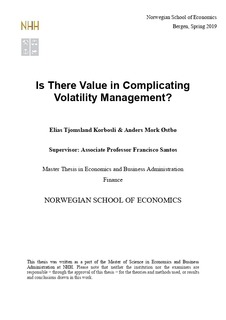| dc.description.abstract | Volatility managed portfolios take less risk when volatility is high, and more risk when volatility is low. Moreira and Muir (2017) employ a simple methodology which scales factor exposure by the inverse of realized variance. Daniel and Moskowitz (2013) propose a more complex method which scales factor exposure by forecasted Sharpe ratio, and demonstrate theoretically that this is superior to just using variance. We examine this proposition by employing their strategy on the stock market factors studied in Moreira and Muir’s paper. To isolate the performance impact of individual return and forecast methods, we also create strategies for all combinations of return and variance forecast in Moreira and Muir’s paper and Daniel and Moskowitz’s.
Both the simple and more complex methods produce large alphas and increased Sharpe ratios over buy-and-hold strategies for a wide range of factors. More interestingly, complicating volatility management beyond that of Moreira and Muir (2017) only has a modest impact on alphas and Sharpe ratios. The more complex variance forecast is not much better than a random walk forecast, and forecasting returns with the more complex methodology does generally not improve performance. The notable exception is Daniel and Moskowitz’s (2013) momentum factor. Complex volatility management does, however, entail other desirable properties. It results in less volatile weights, which reduce transaction and liquidity costs. It also generates more desirable return distributions with improved skewness and kurtosis, which reduce downside risk. | nb_NO |
